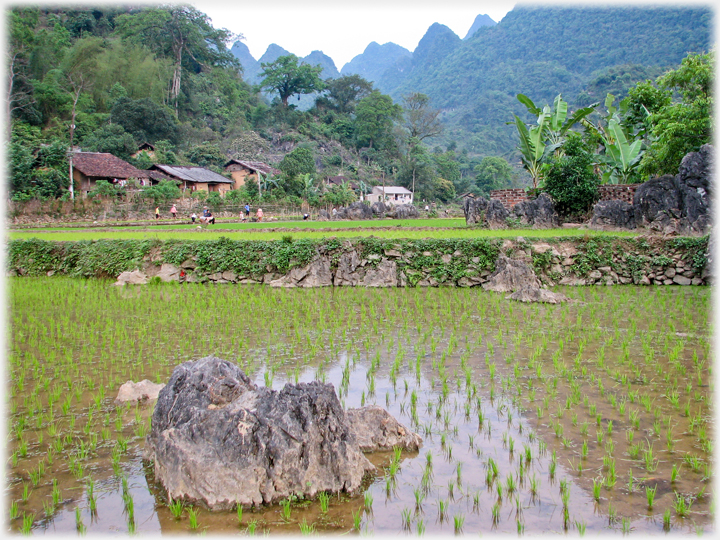 Spring paddy in fields by the village of Pác Bó
Spring paddy in fields by the village of Pác Bó
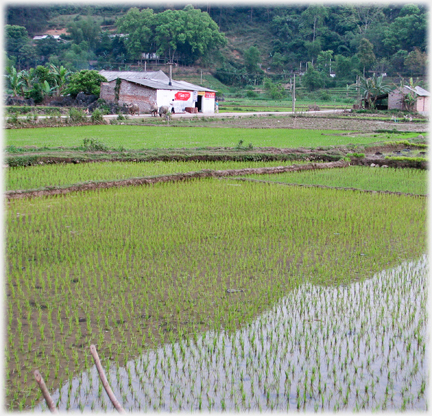 The village shop which offered us accommodation
This page is of very particular interest. It concerns the tiny isolated community of Pác Bó right on the Chinese border in the far north east of Vietnam. Here in 1941 Hồ Chí Minh crossed back from China into his homeland. This return followed decades of preparation in France and then China. Perhaps the photos give you an idea of both how open, and how very remote, the border is here, and hence how easy it was for him to cross back into Vietnam without the Japanese occupational forces knowing of his presence.
The village shop which offered us accommodation
This page is of very particular interest. It concerns the tiny isolated community of Pác Bó right on the Chinese border in the far north east of Vietnam. Here in 1941 Hồ Chí Minh crossed back from China into his homeland. This return followed decades of preparation in France and then China. Perhaps the photos give you an idea of both how open, and how very remote, the border is here, and hence how easy it was for him to cross back into Vietnam without the Japanese occupational forces knowing of his presence.
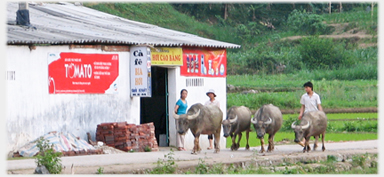 Buffalo welcoming us to our residence
Buffalo welcoming us to our residence
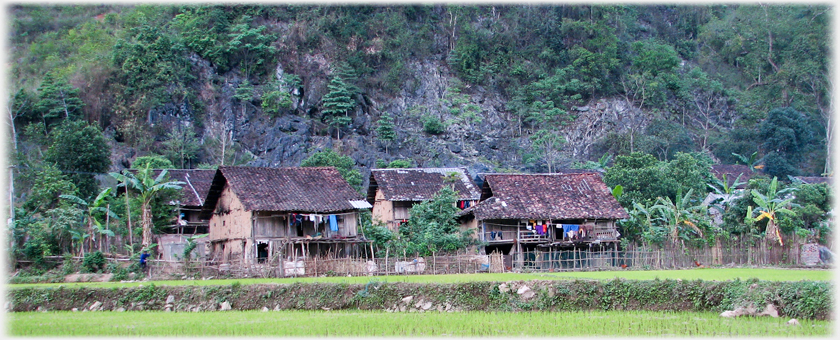 Pác Bó Village houses
Pác Bó Village houses
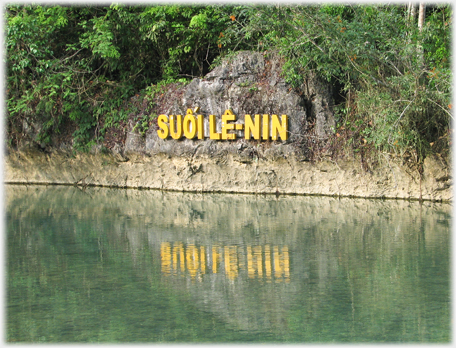 Vietnamese, being a monosyllabic language, renders Lenin as Lê Nin; the sign declares 'River Lenin'...
Vietnamese, being a monosyllabic language, renders Lenin as Lê Nin; the sign declares 'River Lenin'...
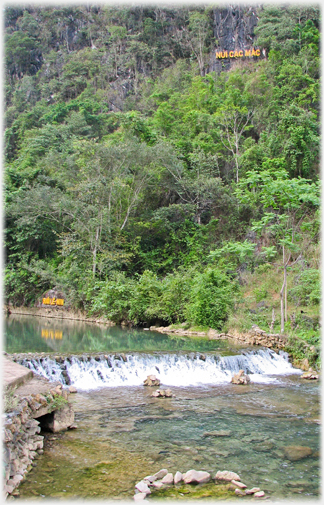 ...and up above, on the hill, the sign reads Marx Hill - Mác being as near as Vietnamese gets to that awkward 'x' sound
...and up above, on the hill, the sign reads Marx Hill - Mác being as near as Vietnamese gets to that awkward 'x' sound
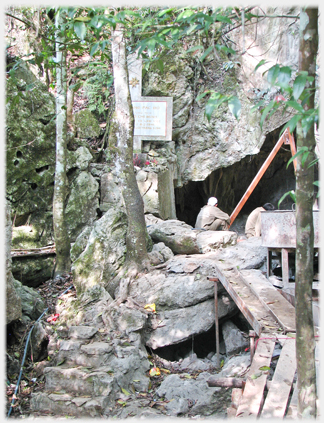 The steps up to the cave where...
The steps up to the cave where...
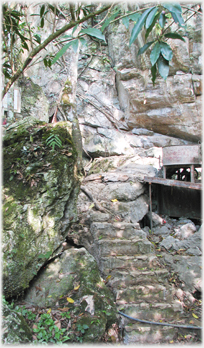 ...Hồ Chí Minh lived during his time in Pác Bó. Left workmen at the cave entrance. Eighty years ago there were no steps...
...Hồ Chí Minh lived during his time in Pác Bó. Left workmen at the cave entrance. Eighty years ago there were no steps...
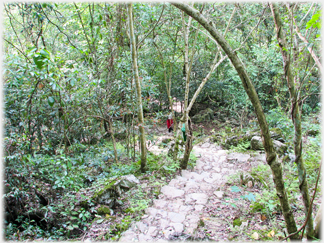 ...running down the hill
...running down the hill
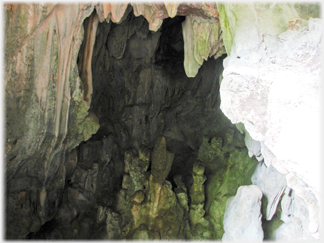 The cave entrance showing something of the utter discomfort that Hồ Chí Minh and his comrades must have had in the weeks that they lived here
The cave entrance showing something of the utter discomfort that Hồ Chí Minh and his comrades must have had in the weeks that they lived here
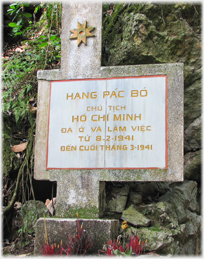 'President Hồ Chí Minh lived and worked here from 8th February till March 1941'
'President Hồ Chí Minh lived and worked here from 8th February till March 1941'
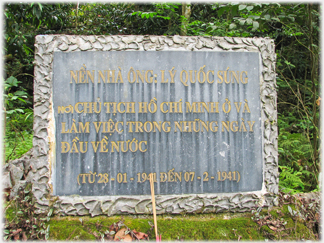 And another sign to the effect that this is where Hồ Chí Minh came back to his home country. The dates record differing aspects of his stay
And another sign to the effect that this is where Hồ Chí Minh came back to his home country. The dates record differing aspects of his stay
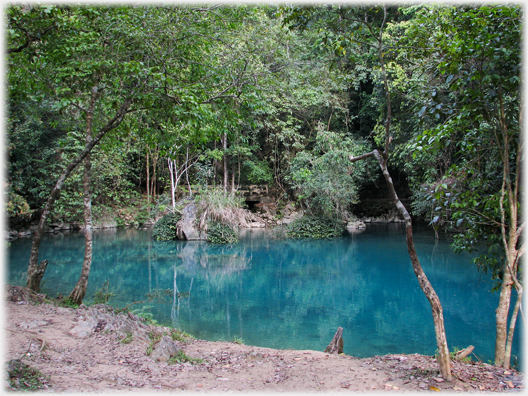
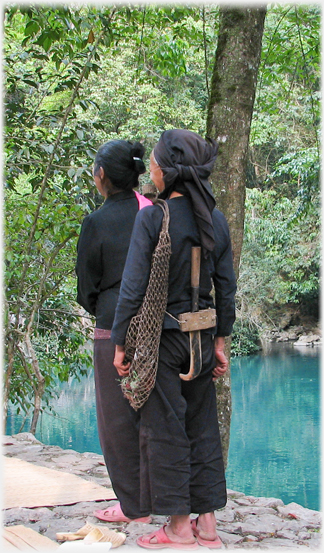 Local women talking to Hân by the pool near the cave - and feeding him eggs. The extraordinary turquoise of the pool is a colour seen often in northern Vietnam. The knife the woman carries is similar to that
seen in the province
Local women talking to Hân by the pool near the cave - and feeding him eggs. The extraordinary turquoise of the pool is a colour seen often in northern Vietnam. The knife the woman carries is similar to that
seen in the province
 of Hà Giang
of Hà Giang
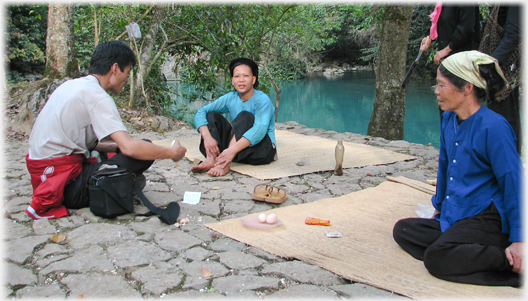
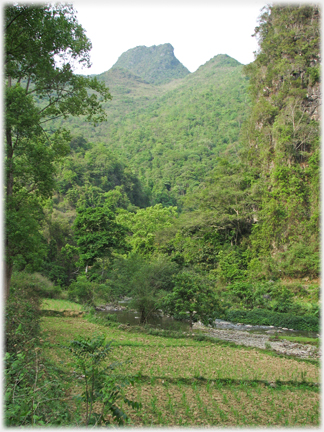 ...and some fields of newly planted corn on the flatter area in the foreground
...and some fields of newly planted corn on the flatter area in the foreground
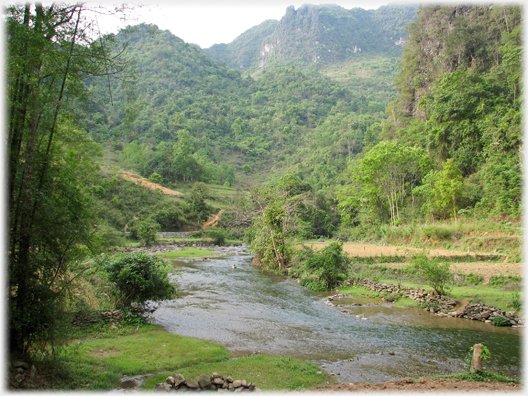 The river which passes the cave winding through a topography of karsts in the distance with thick jungle on the slopes...
The river which passes the cave winding through a topography of karsts in the distance with thick jungle on the slopes...
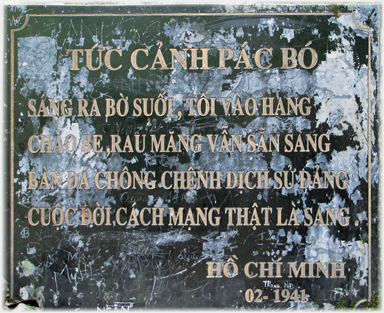
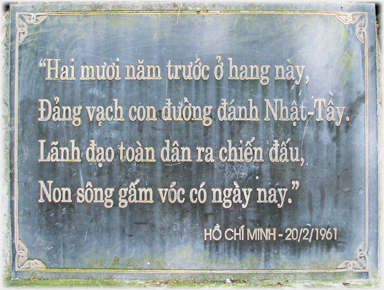 Two poems engraved for visitors at the site, one composed by President Hồ Chí Minh while living at Pác Bó, the other written by him 20 years later
In the morning to the river's bank, in the evening back to the cave
Two poems engraved for visitors at the site, one composed by President Hồ Chí Minh while living at Pác Bó, the other written by him 20 years later
In the morning to the river's bank, in the evening back to the cave
Rice soup, bamboo shoots, simple food, easily available
Like our unstable stone table - so our party evolves
Revolutionary life really is good Twenty years ago in this cave
The Party planned the way to overcome Japan and the West
Leading the whole people into the struggle
Now we have this beautiful homeland
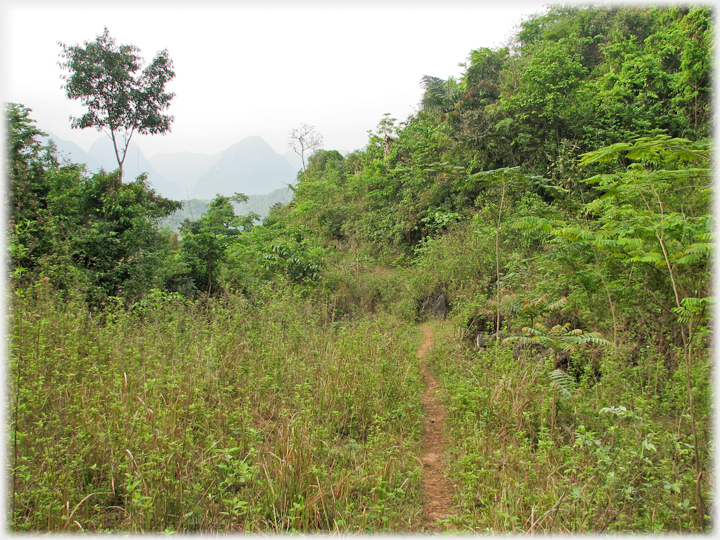 A path in the hills above the cave crossing the border, it might well have been the way Hồ Chí Minh used on his return. There is nothing here showing which country the path is in; the only markers are at one kilometre intervals, as shown below
A path in the hills above the cave crossing the border, it might well have been the way Hồ Chí Minh used on his return. There is nothing here showing which country the path is in; the only markers are at one kilometre intervals, as shown below
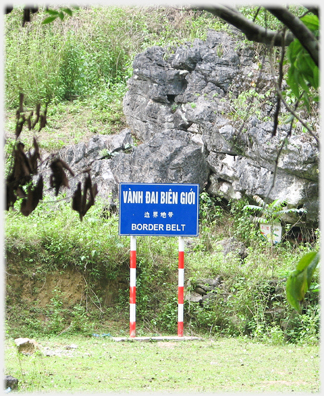 The 'Border Belt' is marked, it requires foreigners to keep clear of the area
The 'Border Belt' is marked, it requires foreigners to keep clear of the area
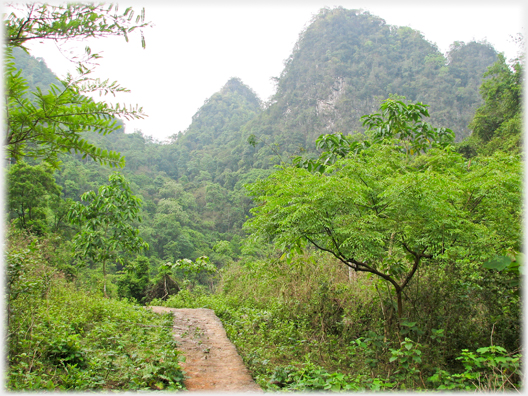 This path is safely within Vietnam. Nothing tells of the border, and local animals (and their owners) wander indifferently across it
This path is safely within Vietnam. Nothing tells of the border, and local animals (and their owners) wander indifferently across it
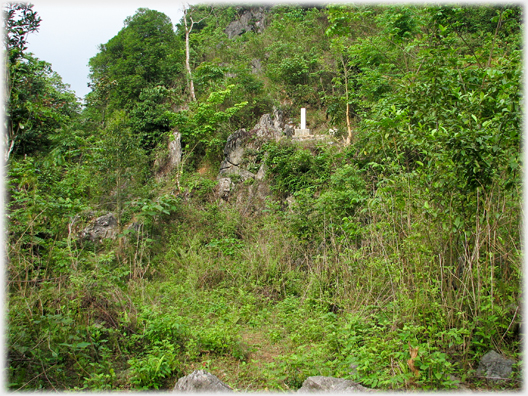 Here are three glimpses of one of the markers that stand at kilometre intervals along the Vietnamese border. Above, its context on the hill...
Here are three glimpses of one of the markers that stand at kilometre intervals along the Vietnamese border. Above, its context on the hill...
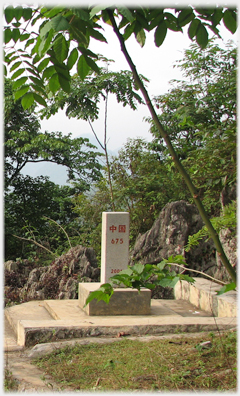 ...and here how the marker looks from the Chinese side
...and here how the marker looks from the Chinese side
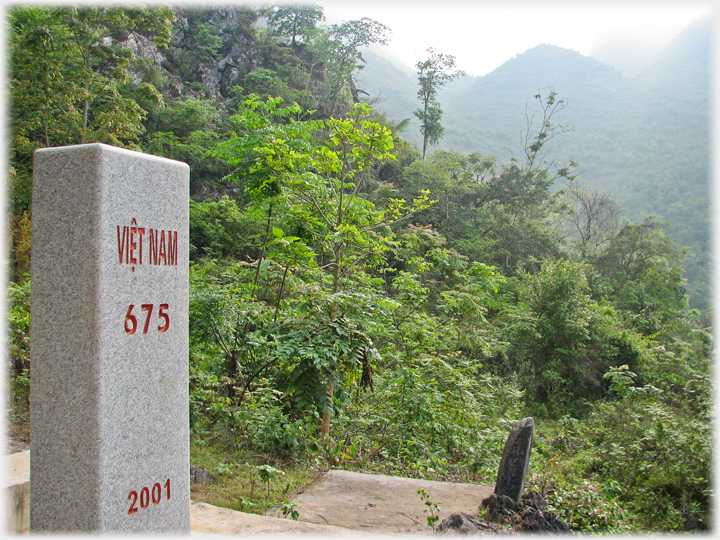 A marker post near Pác Bó from the Vietnamese side. The depth of the remoteness of this place, the sense of being so far from any vestige of power, is profound. There was no way that the French or the Japanese could control this border. Between China and Vietnam alone the border extends to well over 1,250 kilometres, with few proper roads, and much of the border running through dense jungle like this. It was from this remote corner that Hồ Chí Minh set out to lead the 34 year struggle that removed foreign invaders
Trailers...
A marker post near Pác Bó from the Vietnamese side. The depth of the remoteness of this place, the sense of being so far from any vestige of power, is profound. There was no way that the French or the Japanese could control this border. Between China and Vietnam alone the border extends to well over 1,250 kilometres, with few proper roads, and much of the border running through dense jungle like this. It was from this remote corner that Hồ Chí Minh set out to lead the 34 year struggle that removed foreign invaders
Trailers...
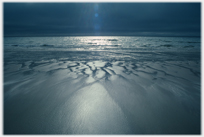 The next page has
images from the far north of a very different country - Iceland
The next page has
images from the far north of a very different country - Iceland
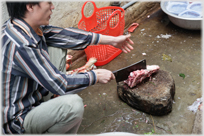 The next page
of the Mosaic Section is headed 'Language cuts nature at her joints'.
The next page
of the Mosaic Section is headed 'Language cuts nature at her joints'.
Or go to the contents of the Mosaic Section.

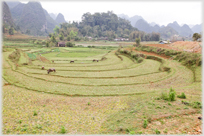 The last page was about the countryside of Cao Bằng
The last page was about the countryside of Cao Bằng
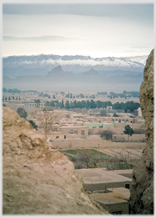
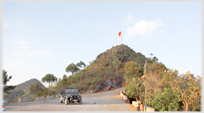 To Lũng Cú, at the northern tip of Vietnam, which has China on three sides
To Lũng Cú, at the northern tip of Vietnam, which has China on three sides
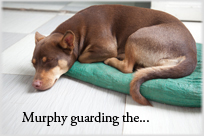 ...guide to this site
...guide to this site